Deep frying on a griddle has its benefits like keeping the smell of fried foods outdoors. But just because you can deep fry on the griddle, doesn’t mean it’s a great idea! Here are our best tips for preparing your favorite fried foods outside on the flat top grill.
Can you deep fry on a griddle? Sure, with the right equipment and a whole lot of patience.
Would I recommend using your Blackstone griddle or other flat top grill for deep frying? Probably not.
As I’ve said in the past, certain pieces of cooking equipment are better suited for some uses than others. Just like you technically could cook a pork butt or a rack of ribs on the griddle, but the pellet grill or smoker is much better for those meats.
But if you’re going to start deep frying on the Blackstone or other flat top grill outdoors, then at least do it safely and efficiently. Whether you want to make crispy chicken, golden french fries, or delicious donuts, you’ll be prepared for deep frying on the griddle with these essential tips:

Why would someone want to deep fry on the Blackstone?
Deep frying on an outdoor griddle, while not the most efficient method, does have its benefits including:
- Keep the Smell Outside: Deep frying on an outdoor griddle allows you to keep the odors that are often associated with deep frying outside, and out of your kitchen and home. Probably one of the biggest benefits of using a griddle to deep fry outdoors!
- Less Mess: Griddles typically have raised sides or splash guards that help contain the hot oil and reduce splatter, making the deep frying process cleaner and safer compared to traditional stovetop frying in open pans.
- Seasoning Opportunity: Deep frying on a griddle provides a unique opportunity to season the cooking surface while you cook. As the hot oil splatters comes into contact with the griddle, you can use a tong and paper towels to spread the oil in a thin layer over the griddle surface, helping to build up the Blackstone griddle seasoning. Also, since your griddle will be on at a fairly high temp to heat the oil for frying, then you can use that time to apply extra coats of seasoning to the surface.
- Easy Cleanup: Cleaning up after deep frying on a griddle is relatively straightforward. Most outdoor griddles have removable grease trays or drip pans that catch excess oil, making disposal easier. The griddle’s flat surface is also easy to wipe down and clean.
- Deep fry a large amount of food at one time: A griddle offers a larger cooking area than a traditional stovetop frying pan, enabling you to fry more food at once. You can prepare multiple large, shallow pans with oil and set them on the griddle surface to heat up, giving you more frying space. This can be a time-saving advantage when cooking for a group or preparing multiple batches of fried items.
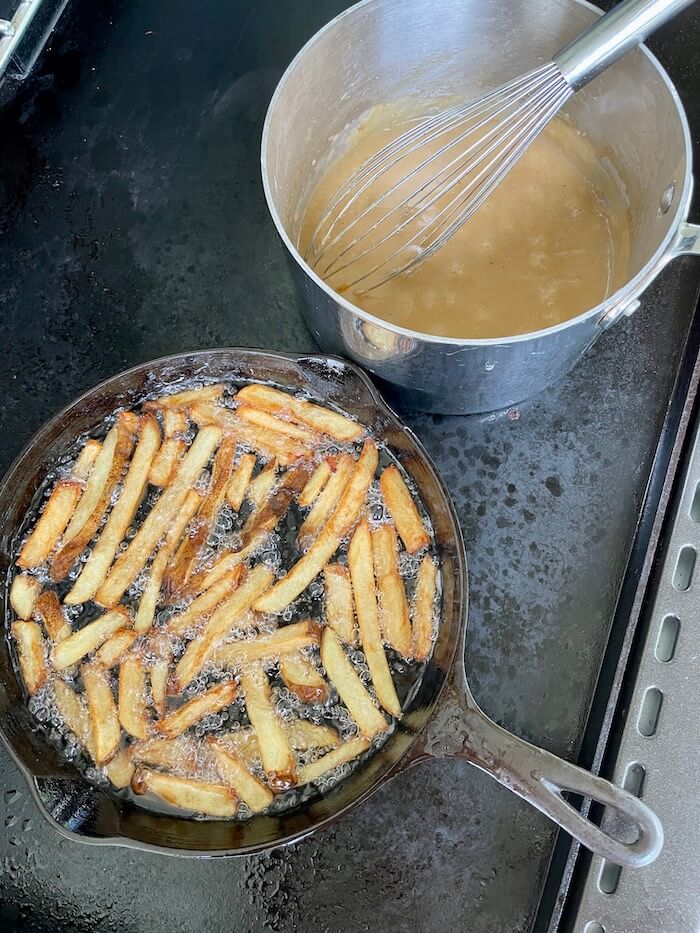
Tips for Deep Frying on the Griddle
Although I feel like there are much better ways to deep fry outdoors, see my recommended alternative methods down below, many people still use their Blackstone griddle or flat top grill for frying foods. So we’ve tested a ton of deep fried foods on the griddle using a variety of pans and methods.
Here are our best tips for deep frying on griddles:
Do NOT Use Aluminum Pans
This is one of the biggest mistakes that I see people make… Adding a bunch of hot oil to a flimsy aluminum pan, and using that for deep frying.
While I understand that aluminum pans reduce the clean up time because you can throw them in the trash afterwards, and they do have a quicker temperature recovery time because the aluminum is thinner and able to heat up more quickly, as a former US Navy cook and restaurant chef with over 13 years of commercial kitchen experience, I have seen way too many accidents happen when dealing with hot oil.
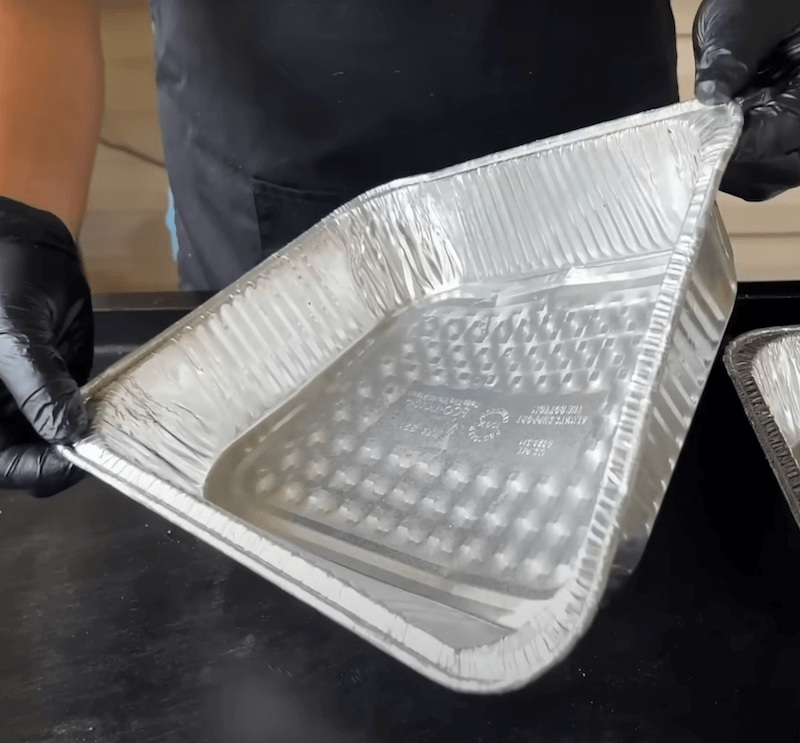
All it takes is for you to accidentally puncture a hole in the side of your aluminum pan, and then you’ve got a large amount of hot oil flowing all over your griddle. And the grease traps of most outdoor flat top grills are too small to hold that amount of oil.
Also, when you add a large amount of hot liquid to those thin disposable aluminum pans, they become more flexible. So if you were to panic and try to lift your pan off the griddle quickly, then you risk spilling a bunch of hot oil out on the griddle and potentially burning yourself.
For those reasons, if you’re going to use the griddle for deep frying wings, fish, or other foods, I would recommend a cast iron skillet or other metal pan.
Choose the Correct Pan for Griddle Deep Frying
Since so many people choose to use their griddles to deep fry foods, we decided to do a test on our YouTube channel recently. We added the same amount of oil to three different types of pans to see which performed the best in terms of heat up time, temperature recovery time, etc.
The three types of pans that we tested on the griddle were:
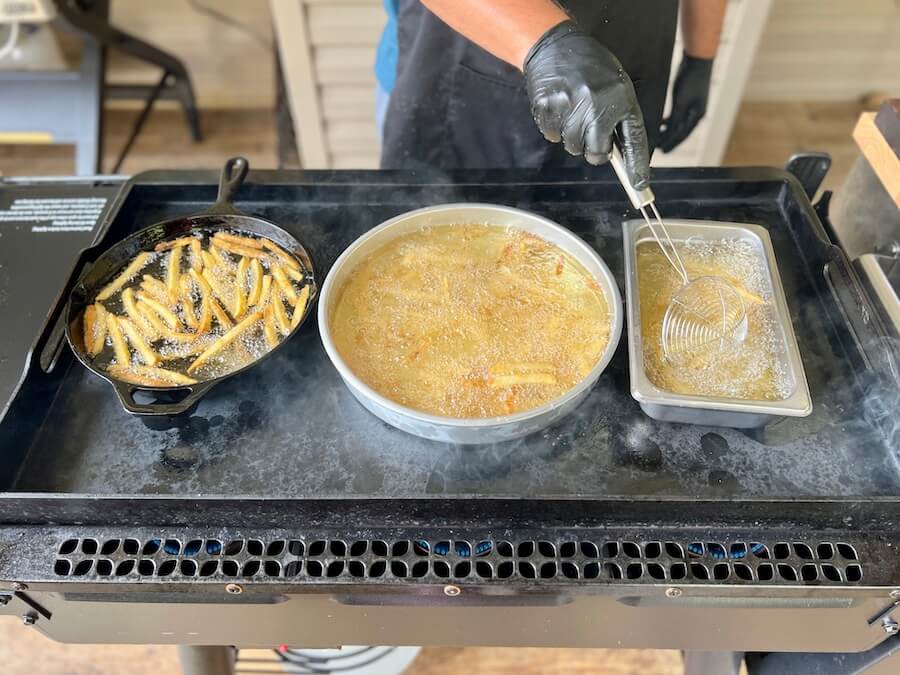
- Cast Iron Skillet – With its ability to retain heat, I expected the cast iron pan to work the best for deep frying, and I was correct. It had the quickest preheat time and it did not have as much temperature loss after adding the cold foods.
- Round Metal Cake Pan – A large Wilton cake pan came in second place for deep frying on the griddle. Although it was not as quick to preheat as the cast iron skillet, the large bottom allowed us to fry more food at one time.
- Restaurant-style Metal Pan – The rectangular-shaped pan on the right was the least efficient pan for deep frying. It took the longest amount of time for the oil to heat up, probably because the bottom was not perfectly flat so it did not have full contact with the griddle surface.
After 13 minutes of preheat time, the oil temperature of the restaurant-style metal pan was only 190 degrees F, the round cake pan was 220 degrees F, and the cast iron skillet oil temp was about 265 degrees F. And this was with the knobs on my Traeger griddle turned to the high setting, so just imagine how much propane I was going through.
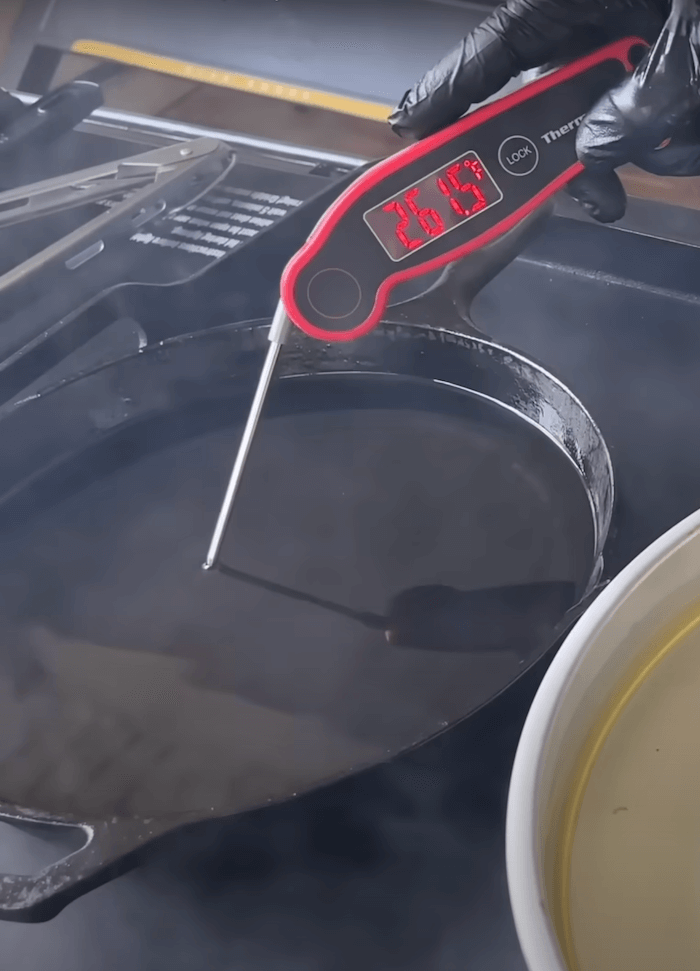
*Keep in mind that the target oil temperature is about 375 degrees F. My alternative methods for frying outdoors were already preheated to 360-370 degrees F by the 13 minute mark.
If you are going to deep fry on the griddle, then I recommend using a cast iron skillet. The cast iron pan retains heat more consistently, helping to maintain a steady oil temperature and recover from the temperature drop that occurs when you add cold foods. And although the oil in the cast iron skillet took a full 26 minutes to preheat, that was still the quickest and most efficient pan to use.
Other Tips for Selecting the Best Pan:
- Be sure that your pan is completely flat on the bottom. If there is any rocking at all, then that means the bottom of your pan is not in full contact with the griddle surface, so it will take longer to heat up.
- A shorter pan or skillet is best. The taller the sides on your pan, the longer it will take your oil to heat up. But be sure that you can fill the pan or skillet ONLY about halfway full with oil and still have enough oil to deep fry. If you add too much oil, it may overflow onto your griddle when you add the food.
Season Your Griddle Top While Frying
Since there’s probably no other food on your griddle surface while you’re deep frying, besides just the pan or skillet of oil, then your griddle surface may dry out during that time. Think back to when you seasoned your Blackstone griddle, and you apply a thin coat of oil, wait for the surface to stop smoking, and then apply another thin coat of oil to build up the seasoning.
Well, if your griddle is set to a high temperature for frying, and you never apply a coat of oil to it, then the surface is prone to drying out. Instead, use tongs and a paper towel with a bit of oil to apply a few coats of seasoning to the griddle surface that is empty. You can do this a few times throughout the frying process to build up some additional seasoning and protect the flat top grill surface.
Use the Correct Deep Frying Oil
Choosing the right cooking oil is a key factor in successful deep frying, whether it’s on a griddle or on the stovetop. Opt for oils with high smoke points, such as vegetable oil, peanut oil, canola oil, or grapeseed oil. These oils can withstand the high temperatures required for deep frying without breaking down and producing off-flavors.
I prefer to use peanut oil for deep frying, though it is one of the more expensive options.
Invest in an Oil or Candy Thermometer
If you’re going to be deep frying frequently, then I recommend purchasing a thermometer specifically for deep frying. These types of thermometers, also called candy thermometers, are designed to clip on to the side of your pan to consistently monitor the oil temperature.
Maintaining a consistent oil temperature is essential for achieving crispy and evenly cooked deep-fried food, and these types of thermometers allow you to closely monitor the oil temperature. Preheat the oil to the desired frying temperature (about 375 degrees F) before adding your food, and make sure that you allow the oil to come back up to the appropriate temperature in between batches.
The Problem With Using Your Blackstone for Deep Frying
My biggest beef with using the griddle as your heat source for deep frying is the amount of time it takes for the oil to heat up initially, as well as the time it takes for the temperature to come back up in between batches of food.
When we did our griddle test to determine which pans were best for frying on the griddle, the average time to heat up the oil for deep frying was about 27-30 minutes. That means that your griddle is on (probably set to a high temperature) for about 30 minutes before you even start frying the first piece of food.
The flames underneath the flat top grill surface have to heat up the griddle first, and then the heat transfers to the frying pan to heat up the oil. It’s simply not efficient, especially considering that most outdoor griddles take about 10-20 minutes to preheat to temperatures in the 400 degree range anyway.
For these reasons, I prefer alternative methods for deep frying outdoors…
Alternatives to Deep Frying on the Blackstone Griddle
If you want to take advantage of the large flat cooking surface of the griddle, AND keep the deep frying odors and mess outside, then you have a few additional and more efficient options for making deep fried foods. In fact, the frying oil in both of the methods below was preheated to 360-375 degrees F in about 13 minutes, half of the time than that of the cast iron skillet on the griddle:
Use a Deep Fryer Outdoors
Instead of firing up your griddle and burning through all of that propane to heat up the oil and get it hot again in between batches, place a deep fryer on the griddle surface. You can keep your Blackstone griddle off and just use the surface as an outdoor table instead. That way when the oil splatters, you can simply take a paper towel and rub it into the griddle surface.

A small deep fryer, like a GranPappy, that is specifically designed for cooking your favorite fried foods like french fries and chicken wings is much more efficient than placing a skillet or pan on the hot griddle surface and frying that way.
Use an Outdoor Electric Burner
My favorite method for deep frying outdoors is to use an electric burner or “hot plate”. When we made fried fish recently, I took my electric portable burner outside and heated the oil in a large dutch oven on the burner. That way, you’re still getting the deep fat fried smell out of your kitchen, but without wasting a bunch of propane to power your griddle.
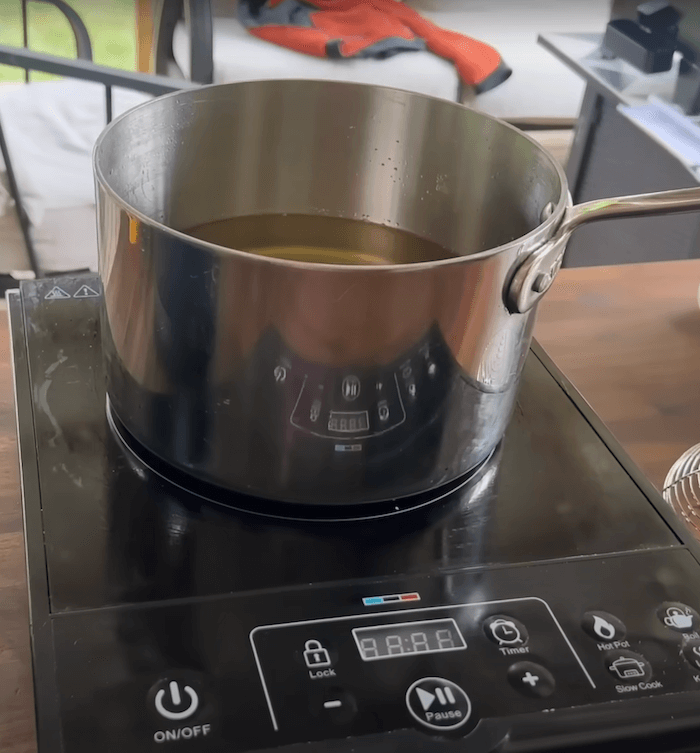
And, the benefit of a single electric burner that you can bring outside is that you can use it for other outdoor meals as well, instead of only for deep frying. I’ve used my outdoor burner to make gravy and other sauces and to boil water for noodles while other items are cooking on the griddle.
Watch my Deep Frying on the Griddle Test HERE
Want to watch me deep fry french fries on the griddle and test out 3 different pans? You can watch the full video on my YouTube channel:
So there you go – my opinions about deep frying on the griddle. Can you deep fry on a griddle? Yes. But is it the most efficient way to make your favorite fried foods? Definitely not.
If you do decide to use your flat top grill or griddle for deep frying outside, just be sure to use the correct pan, season your griddle as you’re frying, and allow plenty of time for heating the oil. With these easy tips (and a bit of patience), you’ll have fantastic crispy fried food on the griddle!
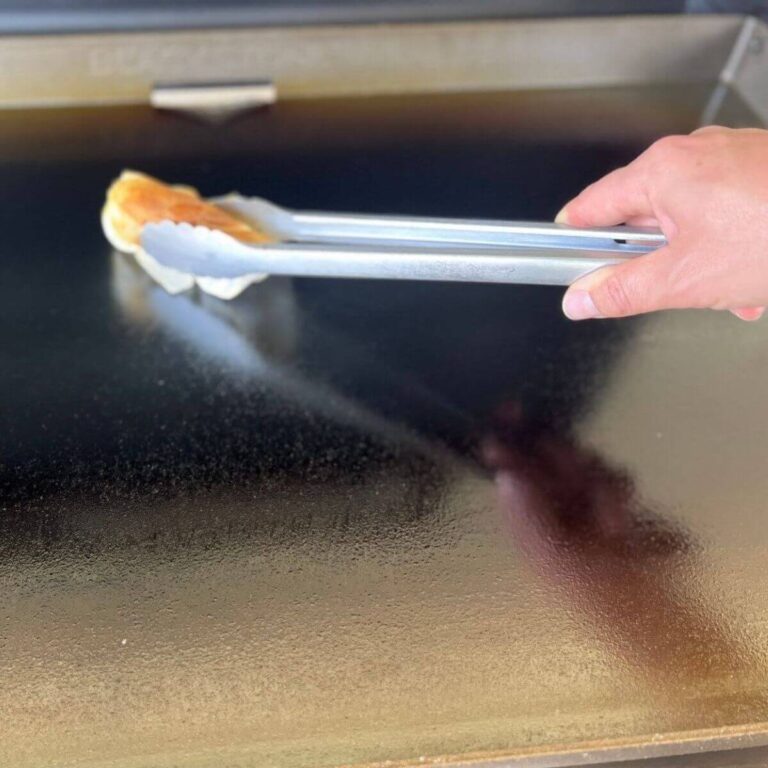

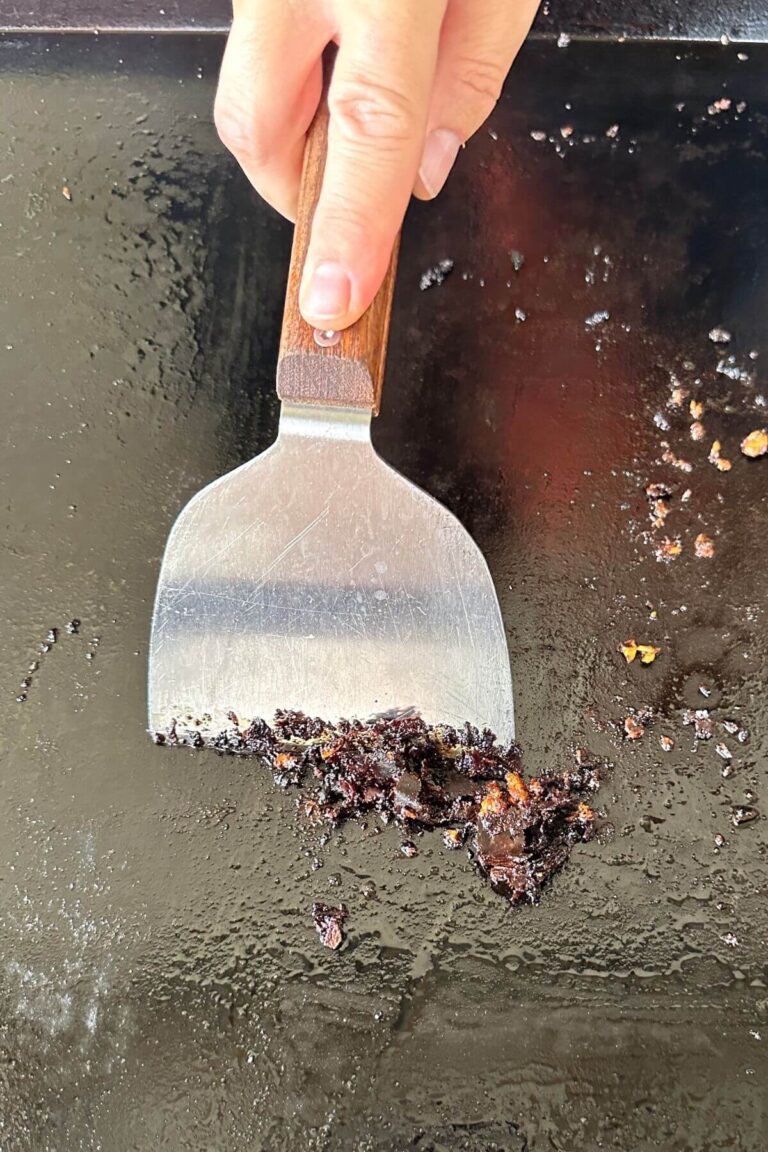
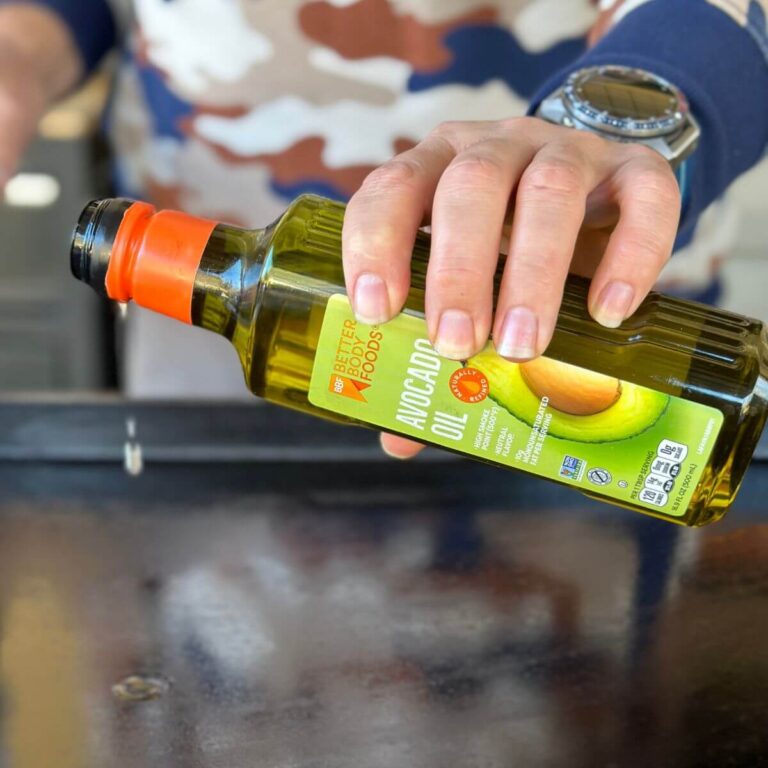
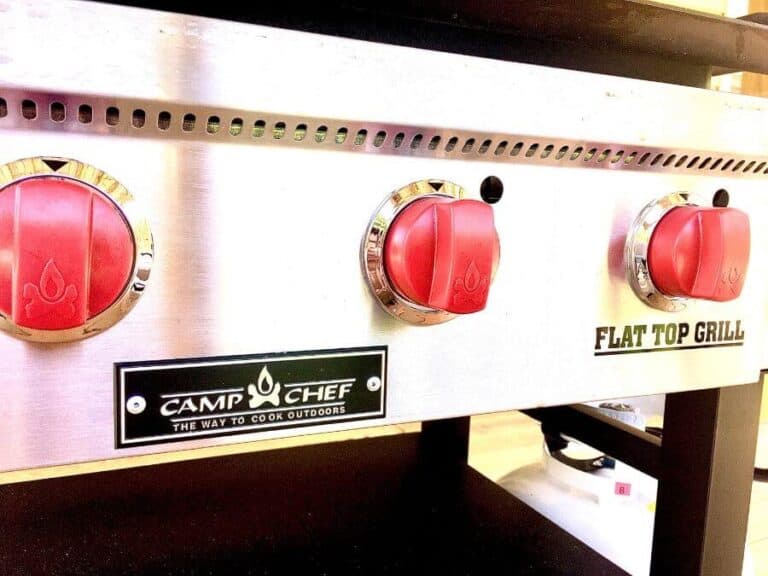
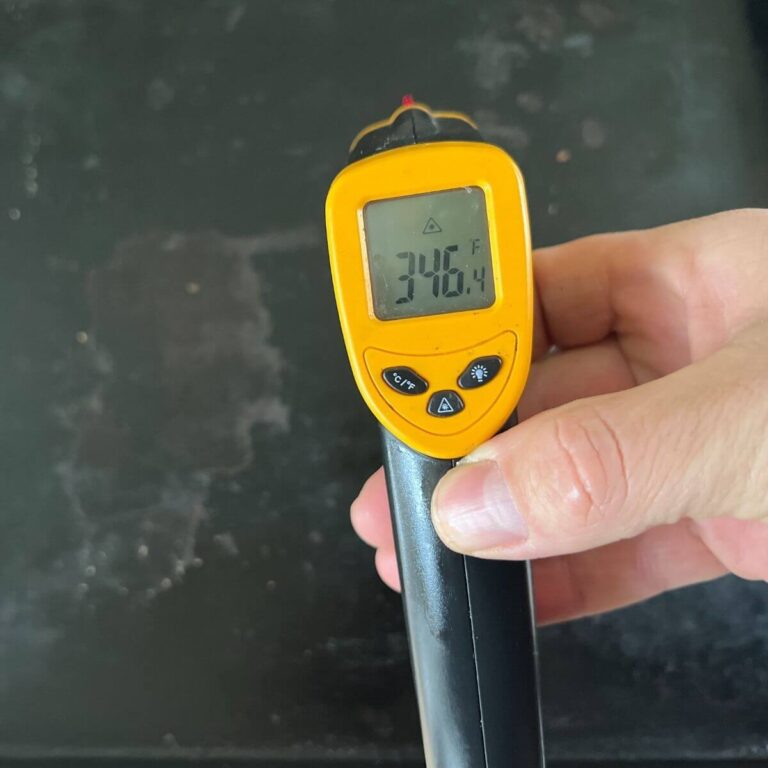


I use the griddle as a table like you say for deep frying, but I use an old Coleman liguid fuel stove and a aluminium pot. It heats the oil very fast and uses very little fuel. Cost for the stove and pot was $3 at a thrift store.